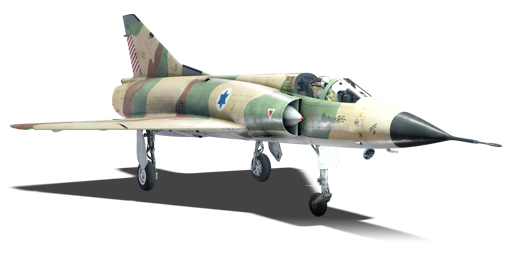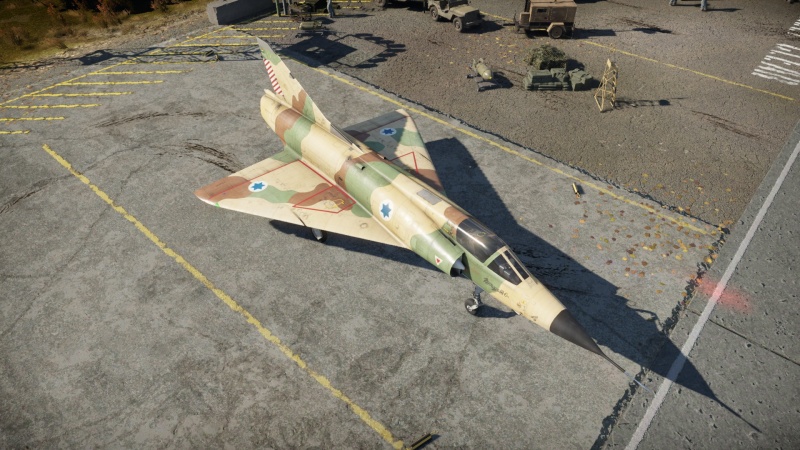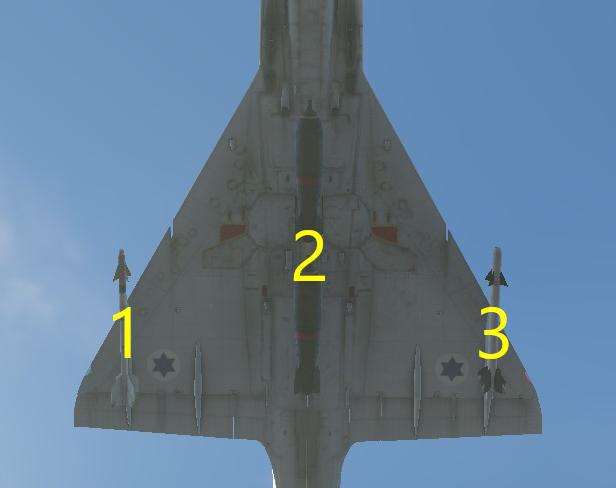Difference between revisions of "Shahak"
m (Updated the Shafrir 2 IR Missiles section in the Usage in battles to describe it to have an uncaged seeker instead of a caged seeker.) (Tag: Visual edit) |
m (history add, little weak tho.) (Tag: Visual edit) |
||
| Line 204: | Line 204: | ||
== History == | == History == | ||
<!-- ''Describe the history of the creation and combat usage of the aircraft in more detail than in the introduction. If the historical reference turns out to be too long, take it to a separate article, taking a link to the article about the vehicle and adding a block "/History" (example: <nowiki>https://wiki.warthunder.com/(Vehicle-name)/History</nowiki>) and add a link to it here using the <code>main</code> template. Be sure to reference text and sources by using <code><nowiki><ref></ref></nowiki></code>, as well as adding them at the end of the article with <code><nowiki><references /></nowiki></code>. This section may also include the vehicle's dev blog entry (if applicable) and the in-game encyclopedia description (under <code><nowiki>=== In-game description ===</nowiki></code>, also if applicable).'' --> | <!-- ''Describe the history of the creation and combat usage of the aircraft in more detail than in the introduction. If the historical reference turns out to be too long, take it to a separate article, taking a link to the article about the vehicle and adding a block "/History" (example: <nowiki>https://wiki.warthunder.com/(Vehicle-name)/History</nowiki>) and add a link to it here using the <code>main</code> template. Be sure to reference text and sources by using <code><nowiki><ref></ref></nowiki></code>, as well as adding them at the end of the article with <code><nowiki><references /></nowiki></code>. This section may also include the vehicle's dev blog entry (if applicable) and the in-game encyclopedia description (under <code><nowiki>=== In-game description ===</nowiki></code>, also if applicable).'' --> | ||
| − | + | In 1952, the French government issued its specification, calling for a lightweight, all-weather interceptor. Amongst the respondents were Dassault with their design, initially known as the Mirage I. Following favourable flight testing held over the course of 1954, in which speeds of up to Mach 1.6 were attained, it was decided that a larger follow-on aircraft would be required to bear the necessary equipment and payloads. An enlarged Mirage II proposal was considered, as well as MD 610 Cavalier (3 versions), but was discarded in favour of a further-developed design, powered by the newly developed Snecma Atar afterburning turbojet engine, designated as the Mirage III. In October 1960, the first major production model, designated as the Mirage IIIC, performed its maiden flight. Initial operational deliveries of this model commenced in July 1961; a total of 95 Mirage IIICs were obtained by the French Air Force (''Armée de l'Air'', AdA). The Mirage IIIC was rapidly followed by numerous other variants. | |
| + | |||
| + | Single-seat all-weather interceptor-fighter aircraft, with longer fuselage than the IIIA (14.73 m (48 ft 4 in)) and equipped with a Cyrano I bis radar. The Mirage IIIC was armed with two 30 mm (1.181 in) cannons, as well as a single Matra R.511, Nord AA.20 or Matra R530 air-to-air missile under the fuselage and two AIM-9 Sidewinder missiles under the wings. It was powered by an Atar 9B-3 turbojet engine, which could be supplemented by fitting an auxiliary rocket motor in the rear fuselage if the cannons were removed. 95 were built for the French Air Force | ||
| + | |||
| + | Mirage IIIC for the Israeli Air Force, fitted with simpler electronics and with provision for the booster rocket removed. | ||
== Media == | == Media == | ||
Revision as of 00:07, 11 September 2023
Contents
Description
The Mirage IIICJ (Shahak) is a rank VII Israeli jet fighter with a battle rating of 10.0 (AB/RB) and 10.3 (SB). It was introduced in Update "Winged Lions".
General info
Flight performance
| Characteristics | Max Speed (km/h at 12,000 m) |
Max altitude (metres) |
Turn time (seconds) |
Rate of climb (metres/second) |
Take-off run (metres) | |||
|---|---|---|---|---|---|---|---|---|
| AB | RB | AB | RB | AB | RB | |||
| Stock | 2,084 | 2,042 | 16000 | 29.6 | 30.2 | 108.9 | 96.9 | 750 |
| Upgraded | 2,240 | 2,160 | 26.5 | 28.0 | 173.4 | 140.0 | ||
Details
| Features | |||||
|---|---|---|---|---|---|
| Combat flaps | Take-off flaps | Landing flaps | Air brakes | Arrestor gear | Drogue chute |
| X | X | X | ✓ | X | ✓ |
| Limits | ||||||
|---|---|---|---|---|---|---|
| Wings (km/h) | Gear (km/h) | Flaps (km/h) | Max Static G | |||
| Combat | Take-off | Landing | + | - | ||
| 1,460 | 426 | - | - | - | ~12 | ~5 |
| Optimal velocities (km/h) | |||
|---|---|---|---|
| Ailerons | Rudder | Elevators | Radiator |
| < 920 | < 750 | < 650 | - |
Engine performance
| Engine | Aircraft mass | |||||
|---|---|---|---|---|---|---|
| Engine name | Number | Basic mass | Wing loading (full fuel) | |||
| SNECMA Atar 9B | 1 | 6,340 kg | 258 kg/m2 | |||
| Engine characteristics | Mass with fuel (no weapons load) | Max Takeoff Weight | ||||
| Weight (each) | Type | 8m fuel | 20m fuel | 28m fuel | ||
| 1,333 kg | Afterburning axial-flow turbojet | 6,900 kg | 7,673 kg | 8,206 kg | 10,950 kg | |
| Maximum engine thrust @ 0 m (RB/SB) | Thrust to weight ratio @ 0 m (WEP) | |||||
| Condition | 100% | WEP | 8m fuel | 20m fuel | 28m fuel | MTOW |
| Stationary | 4,230 kgf | 6,090 kgf | 0.88 | 0.79 | 0.74 | 0.56 |
| Optimal | 5,118 kgf (1,200 - 1,400 km/h) |
8,253 kgf (1,400 km/h) |
1.20 | 1.08 | 1.01 | 0.75 |
Survivability and armour
Due to the size of the Shahak, its survivability is rather low. The large engine that covers almost half the length of your fuselage is very vulnerable to enemy fire. Any damage which will significantly decrease your power output and the massive wings will lose a large amount of lift when damaged.
The plane includes an RWR (radar warning receiver), which can be rather helpful.
Modifications and economy
Armaments
Offensive armament
The Shahak is armed with:
- 2 x 30 mm DEFA 552A cannons, belly-mounted (125 rpg = 250 total)
Suspended armament
The Shahak can be outfitted with the following ordnance:
| 1 | 2 | 3 | ||
|---|---|---|---|---|
| 250 kg SAMP Type 25 bombs | 2 | |||
| 250 kg SAMP Type 25 200 bombs | 2 | |||
| 400 kg SAMP Type 21 bombs | 2 | |||
| 400 kg SAMP Type 21 200 bombs | 2 | |||
| AIM-9D Sidewinder missiles | 1 | 1 | ||
| Matra R530 missiles | 1 | |||
| Matra R530E missiles | 1 | |||
| Shafrir 2 missiles | 1 | 1 |
| Default weapon presets | |
|---|---|
| |
Usage in battles
In Air RB, it is recommended to climb and use your decent radar and Matra R530 SARH missiles against unsuspecting aircraft (such as Harriers, A-5C, F-5C, MiG-21S and more). The R530 missile has pretty good range and can hit opponents coming head-on even when launched from the maximum range (~12 km or 7.5 mi at ~5 km or ~3 mi altitude or more) while also being agile enough to hit targets that try to manoeuvre at higher altitudes.
The aircraft also comes with the Matra R530E which is the infrared variant of the R530. It can be used at medium range at high altitude (preferable side-on) but it will be a missile that you rarely use since you have access to two AIM-9D missiles that are superior to the 530E. The R530E could then be traded for bombs or the regular R530 which also has all-aspect capabilities.
There is also the Shafrir 2 IR missile which has great manoeuvrability, as well as a long motor burn time. However, the missile has a relatively short range, and can have difficulty hitting targets going the same speed as you at low altitude. the uncaged seeker helps this missile alot with turning targets by allowing you to lead the missile.
The AIM-9D is one of the longest-range missiles of the AIM-9 family, featuring a motor and aerodynamics almost identical to the AIM-9G/9H with an inferior seeker head and gimbal limits. It can effectively destroy aircraft 5-6 km rear aspect at ~5 km, ~3 mi altitude or more with the only drawback being that it is angled downwards with a caged seeker before launch making it slightly harder to use.
The aircraft itself features a powerful engine and a delta wing configuration which allow it to accelerate at a decent rate and have great maneuverability but the control surfaces become less responsive at higher altitudes.
In summary, a valid tactic is to start climbing at 20-25 degrees once you take off until you reach an altitude where your missiles can use their full range at the start of the battle, use your radar to lock on an enemy and fire your R530 missiles hopefully scoring a kill while avoiding sharp turns and doing your best to keep your speed high. Having high speed not only makes it harder for enemies to catch up to you or use their missiles to hit you, it also makes your missiles have an even longer range. Once you see that there are no more enemies at your altitude, there are most likely either a few running people on the enemy team left or there is a furball. In both cases you have the ability to sneak up on the enemy from your higher altitude and fire your missiles off scoring even more kills. One thing to keep in mind though is that the AIM-9D pulls too much lead when fired off from side-aspect so it will be easier to dodge.
Pros and cons
Pros:
- Greatly manoeuvrable
- Good air-to-air missiles
- 30 mm DEFA cannons are deadly at close ranges
Cons:
- Bleeds speed fairly quickly in sharp turns
- No countermeasures (no flares or chaff)
History
In 1952, the French government issued its specification, calling for a lightweight, all-weather interceptor. Amongst the respondents were Dassault with their design, initially known as the Mirage I. Following favourable flight testing held over the course of 1954, in which speeds of up to Mach 1.6 were attained, it was decided that a larger follow-on aircraft would be required to bear the necessary equipment and payloads. An enlarged Mirage II proposal was considered, as well as MD 610 Cavalier (3 versions), but was discarded in favour of a further-developed design, powered by the newly developed Snecma Atar afterburning turbojet engine, designated as the Mirage III. In October 1960, the first major production model, designated as the Mirage IIIC, performed its maiden flight. Initial operational deliveries of this model commenced in July 1961; a total of 95 Mirage IIICs were obtained by the French Air Force (Armée de l'Air, AdA). The Mirage IIIC was rapidly followed by numerous other variants.
Single-seat all-weather interceptor-fighter aircraft, with longer fuselage than the IIIA (14.73 m (48 ft 4 in)) and equipped with a Cyrano I bis radar. The Mirage IIIC was armed with two 30 mm (1.181 in) cannons, as well as a single Matra R.511, Nord AA.20 or Matra R530 air-to-air missile under the fuselage and two AIM-9 Sidewinder missiles under the wings. It was powered by an Atar 9B-3 turbojet engine, which could be supplemented by fitting an auxiliary rocket motor in the rear fuselage if the cannons were removed. 95 were built for the French Air Force
Mirage IIIC for the Israeli Air Force, fitted with simpler electronics and with provision for the booster rocket removed.
Media
- Skins
- Videos
See also
- Related development
External links
Paste links to sources and external resources, such as:
- topic on the official game forum;
- other literature.
| Dassault Aviation | |
|---|---|
| WW2* | |
| Fighters | M.B.152C1 · M.B.157 |
| Bombers | M.B.162 · M.B.174A-3 · M.B.175T |
| Jet Aircraft | |
| M.D 450 | M.D.450B Barougan · M.D.450B Ouragan |
| Mystère | M.D.452 IIA · M.D.452 IIC · Mystere IVA |
| Super Mystère | Super Mystere B2 |
| Étendard | Etendard IVM |
| Super Étendard | Super Etendard |
| Alpha Jet | Alpha Jet E** |
| Mirage | |
| Mirage III | Mirage IIIC · Mirage IIIE · Milan |
| Mirage V | Mirage 5F |
| Mirage F1 | Mirage F1C · Mirage F1C-200 · Mirage F1CT |
| Mirage 2000 | Mirage 2000-5F · Mirage 2000C-S4 · Mirage 2000C-S5 · Mirage 2000D-R1 · Mirage 2000D-RMV |
| Mirage 4000 | Mirage 4000 |
| Export | |
| M.D 450 | M.D.450B Ouragan |
| Mystere | Mystere IVA |
| Super Mystère | Sambad · Sa'ar*** |
| Mirage | Shahak · ▄Mirage 5BA · ␗Mirage 2000-5Ei |
| *The company was named "Société des Avions Marcel Bloch" before being renamed in 1947 | |
| **Jointly manufactured with Dornier Flugzeugwerke | |
| ***Israeli Super Mystère refitted with new avionics and an American engine | |
| See also | SABCA |
| Israel jet aircraft | |
|---|---|
| Kfir Canard · Kfir C.2 · Kfir C.7 · Nesher | |
| Britain | |
| Meteor | Meteor NF.13 · Meteor F.8 |
| France | |
| Vautour | Vautour IIA · Vautour IIN |
| Super Mystere | Sambad · Sa'ar |
| Mirage III | Shahak |
| Other | M.D.450B Ouragan · Mystere IVA |
| USA | |
| F-84 | F-84F |
| A-4 | A-4H · A-4E Early (M) · A-4E · Ayit |
| F-4 | Kurnass · Kurnass 2000 |
| F-15 | Baz · Baz Meshupar · F-15I Ra’am |
| F-16 | Netz · F-16C Barak II · F-16D Barak II |






